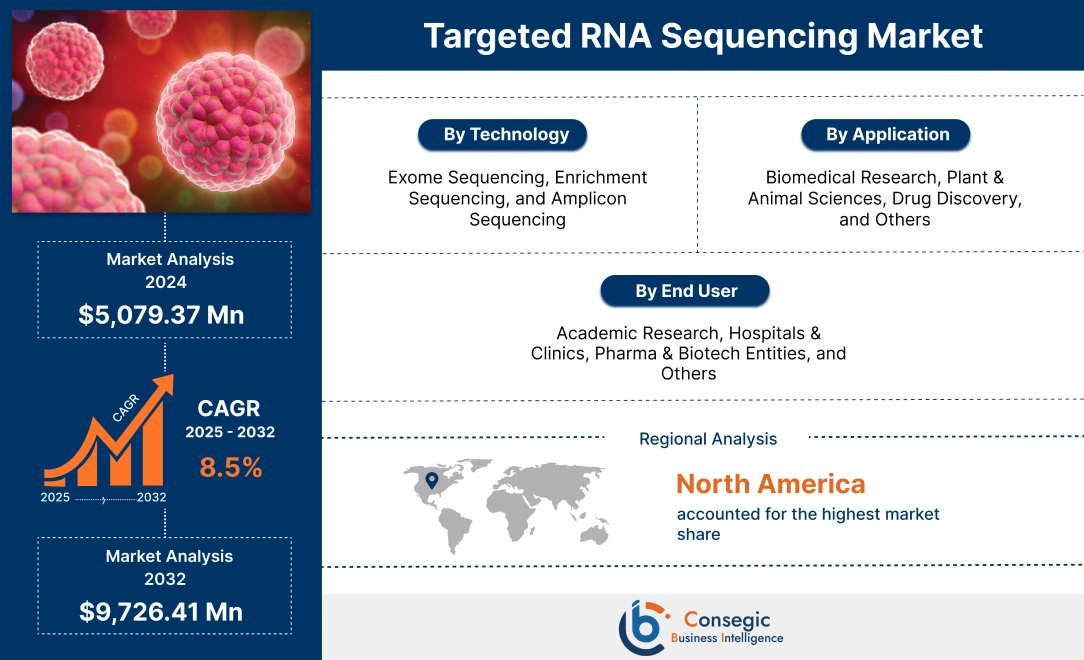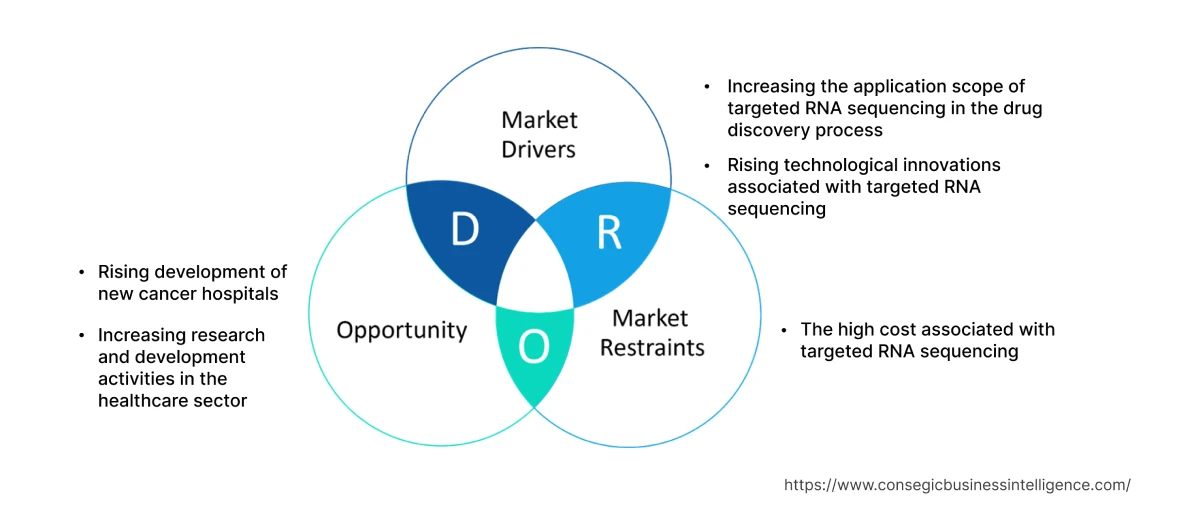Targeted RNA Sequencing Market Size :
Consegic Business Intelligence analyzes that the Targeted RNA Sequencing market size is growing with a healthy CAGR of 8.5% during the forecast period (2025-2032), and the market is projected to be valued at USD 9,726.41 Million by 2032 from USD 5,079.37 Million in 2024.
Targeted RNA Sequencing Market Scope & Overview :
Targeted RNA sequencing is a highly accurate approach for appointing and sequencing specific transcripts of interest. It offers both quantitative and qualitative information. It is attained through amplicon or enrichment-based methods that ensure gene expression analysis in a targeted set of genes. This method is vital for the healthcare industry to ensure superior accuracy and specification for measuring transcripts of interest.
Exome sequencing, enrichment sequencing, and amplicon sequencing are the several types of technologies used in the sequencing procedure. Such types of technologies are used in several applications including biomedical research, plant & animal sciences, drug discovery, and others. Targeted RNA enrichment Sequencing offers the following features,
- -Compatible with difficult samples such as FFPE tissue
- -Low input (requires 10 ng of total RNA or 20 – 100 ng of FFPE RNA)
- -Detects both known and novel fusion gene partners
- -Profiles gene expression with a broad dynamic range
Targeted RNA Sequencing Market Insights :
Targeted RNA Sequencing Market Dynamics - (DRO) :
Key Drivers :
Increasing the application scope of targeted RNA sequencing in the drug discovery process
It is a highly accurate method for the efficient study of drug-induced changes in gene expression across the genome. As a result, the these sequencing aspect can assess a drug's global transcriptional effects and substantially speed up the procedure for the identification of the new drug target.
Moreover, rising investments in the drug discovery process ensure the increasing process of discovery of potential drug targets. The growing adoption of these sequencing ensures the scalability process of the drug discovery process.
Drug discovery faces a significant challenge in identifying potential drug target genes, whereas this sequencing is a powerful method for the studying of new drugs. RNA sequencing makes the process of drug discovery effective, for this reason, increasing the application scope of this sequencing in drug discovery is boosting the demand of the market.
Rising technological innovations associated with targeted RNA sequencing
Global players in the targeted RNA sequencing market are substantially investing in the technological innovations of this sequencing to increase their product offerings in the market. As a result of this, the manufacturers, having their presence at the global level, are continuously leveraging their technological potential to develop new methods with updated technological advancements. Thus, the development of new sequencing with upgraded technology is leading to the rise of the targeted RNA sequencing industry.
For illustration, in October 2020, Oxford Nanopore Technologies, launched multiple products, including single-molecule accuracy, raw-read accuracy, high consensus accuracy, and other solutions to ensure high-accuracy, content-rich, superior-throughput whole-genome sequencing, and dynamic targeted sequencing for RNA. Hence, the increasing new technological developments of these sequencing by various global companies are amplifying the expansion of the global targeted RNA sequencing market.
Key Restraints :
The high cost associated with targeted RNA sequencing
These methods ensure superior data quality, owing to this factor the utilization of targeted RNA sequencing is increasing in hospitals, research institutes, and others. However, the deployment of this sequencing adds to the labor, time, and cost required, thereby deteriorating the amount of the original sample, which is a key challenge when working with needle biopsies, single cells, or rare transcripts.
For instance, the utilization of this sequencing minimizes the number of samples to be batched together in a single library and enhances the cost per sample and time. Additionally, the primer amplification-based aspects of this sequencing have demonstrated difficulty in developing a set of primers for each target, and as a result, content is primarily limited to 500 to 1000 genes. Thus, these approaches require extraction and reverse transcription, which further results in addition to the overall cost. Thus, the above cost factors associated with this sequencing are expected to restrain market trend in the upcoming years.
Future Opportunities :
Rising development of new cancer hospitals
The rise in the development of new cancer hospitals is creating lucrative targeted RNA sequencing market opportunities and trends in the upcoming years. This method is an ideal option for cancer hospitals to determine the variants in cancer samples. Also, these sequencing efficiently analyzes the gene expression signatures and mutational profiles related to single cells, individual tumors, and tumor types. Based on the analysis, the surge in the cases of cancer, increasing government initiatives for the healthcare infrastructure, and among others are some of the critical factors accelerating the development of highly advanced hospital facilities. These factors will drive the demand for this sequencing.
For instance, as of April 2023, the development of Regional Cancer Hospitals is under the construction phase in major Indian cities such as Kurnool and Visakhapatnam. The construction of the new cancer hospitals in India will be completed by September 2024.
Thus, the advent of new cancer hospital developments in countries such as the United States, India, and others will boost the treatment of various cancers. This critical variable will boost the opportunities and trends of the global targeted RNA sequencing market in the forecast period.
Increasing research and development activities in the healthcare sector
In academic research, the utilization of this method is important for the study of disease research and therapy discovery, including biomedical research, drug resistance, and others. The research and development investment for healthcare is increasing at the global level due to the increasing government initiatives, and collaborations with public and private players, among others. Thus, the increasing investments in research and development activities will lead to the accelerating testing of RNA in academic and research institutions will accelerate market.
For instance, according to the United States National Center for Science and Engineering Statistics, in 2021, the research and development in the United States healthcare sector was valued at USD 27,532 million, an increase of 8.5% from USD 25,372 in 2020. As a result, based on the analysis, the targeted RNA sequencing market demand will increase at the global level to ensure a seamless template. This factor will drive market trend at the global level in the upcoming years.
Targeted RNA Sequencing Market Report Insights :
| Report Attributes | Report Details |
| Study Timeline | 2019-2032 |
| Market Size in 2032 | USD 9,726.41 Million |
| CAGR (2025-2032) | 8.5% |
| By Technology | Exome Sequencing, Enrichment Sequencing, and Amplicon Sequencing |
| By Application | Biomedical Research, Plant & Animal Sciences, Drug Discovery, and Others |
| By End-User | Academic Research, Hospitals & Clinics, Pharma & Biotech Entities, and Others |
| By Region | North America, Europe, Asia-Pacific, Latin America, and Middle East & Africa |
| Key Players | Roche Holdings, Thermo Fisher Scientific, Illumina, Inc., Agilent Technologies, Oxford Nanopore Technologies, DNASTAR Inc., QIAGEN, BGI, Bio-Rad Laboratories, Inc., and PierianDx |
Targeted RNA Sequencing Market Segmental Analysis :
By Technology :
The technology segment is categorized into exome sequencing, enrichment sequencing, and amplicon sequencing. In 2024, the exome sequencing segment accounted for the highest market share of 42.50% in the overall targeted RNA sequencing market. The vital benefits associated with exome sequencing include efficient analysis of difficult samples without sacrificing the gene fusion discovery power. The exome sequencing methods target the defined number of known transcripts, owing to this exome sequencing control the challenges of high cost by combining sequencing with exome enrichment.
Furthermore, the major players in the global targeted RNA sequencing market are actively adopting exome sequencing technology. For instance, Illumina, Inc is utilizing exome sequencing technology for this sequencing to ensure enhancement in the accuracy of results. This prime determinant is accelerating market.
Furthermore, as per the analysis, enrichment sequencing is expected to be the fastest-growing segment in the market over the forecast period. This is due to the increasing demand for enrichment sequencing technology to efficiently identify novel variants.
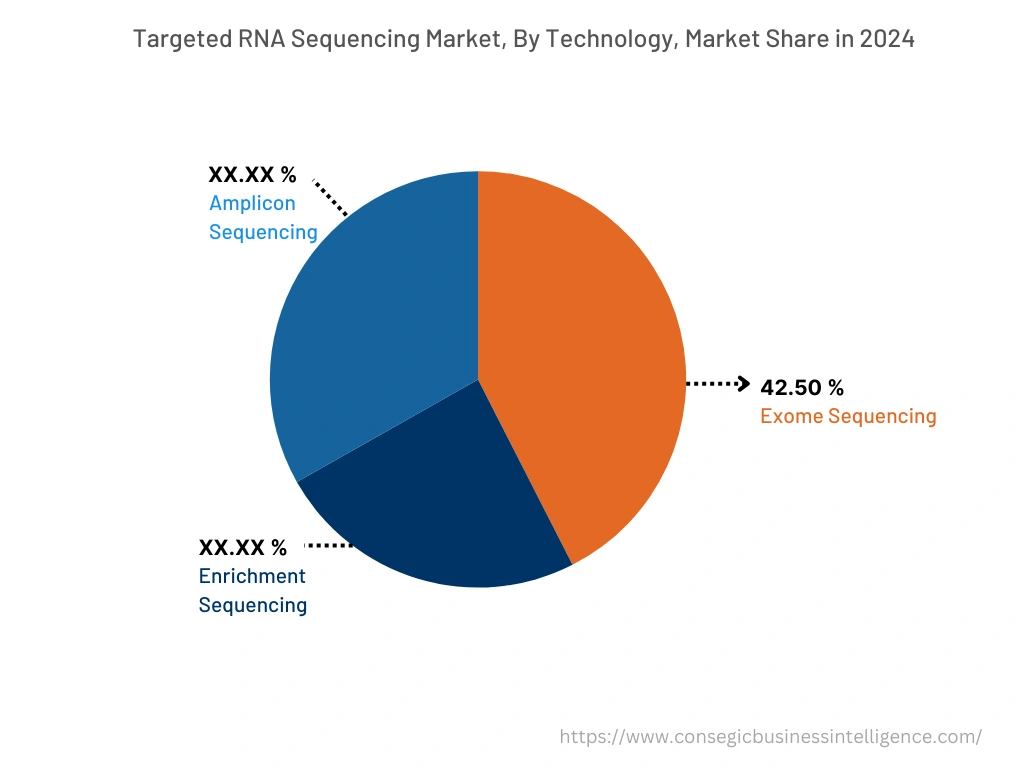
By Application :
The application segment is categorized into biomedical research, plant & animal sciences, drug discovery, and others. In 2024, the drug discovery segment accounted for the highest market share in the targeted RNA sequencing market. This sequencing is deployed in drug discovery to examine the possible effects of drug treatment on cells. In addition, the sequencing uses the sensitive read-out of gene expression for the whole transcriptome. As per the analysis, the increase in drug discovery applications is attributed due to the factors such as the increasing prevalence of chronic disease, the increasing development of new drug research centers, and others.
In March 2023, the Canadian government announced a USD 59 million Canadian Critical Drug Initiative to boost drug discovery research, commercialization, and manufacturing in Canada. These initiatives will boost the activities associated with new drug discovery, thereby creating a prominent potential for targeted RNA sequencing market growth.
However, biomedical research is expected to be the fastest-growing segment during the forecast period because increasing development of new pharmaceutical drugs for various chronic diseases such as Cancer, and Chronic Obstructive Pulmonary Disease (COPD), among others. This, in turn, is fostering higher accuracy RNA sequencing, and as a result, the demand and trend for this sequencing is increasing.
By End User :
The end user segment is categorized into academic research, hospitals & clinics, pharma & biotech entities, and others. In 2024, the academic research segment accounted for the highest market share in the targeted RNA sequencing market driven by the increasing research and development activities associated with RNA-based drug discovery and study in institutional research centers. Moreover, the product innovations associated with sequencing, including RNA sequencing library prep, exome sequencing, and others are further boosting the revenue component of the academic research segment.
For instance, various prominent institutional research centers are active users of sequencing, including SUNY Upstate Medical University (UMU), the University of Missouri-St. Louis, and others. These players have adopted sequencing manufactured by Illumina. Henceforth, the increasing adoption of this sequencing in academic research is boosting market trend.
However, the hospital segment is expected to be the fastest-growing segment in the targeted RNA sequencing market during the forecast period. This is due to the increasing adoption of highly accurate systems in hospitals to ensure superior reliability in qualitative and quantitative information. Furthermore, the development of new healthcare facilities is expected to boost the demand for this sequencing, thereby creating a potential for segment expansion and trend in the long run.
By Region :
The regional segment includes North America, Europe, Asia Pacific, the Middle East and Africa, and Latin America.
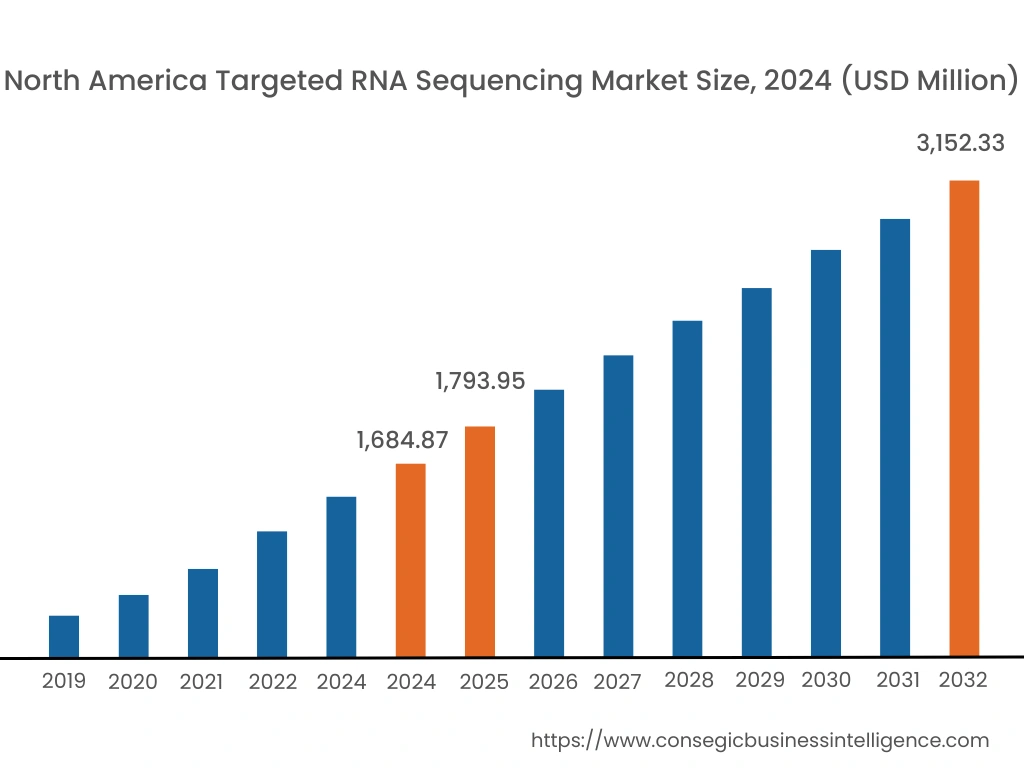
In 2024, North America accounted for the highest targeted RNA sequencing market share at 40.45% and was valued at USD 1,684.87 million and is expected to reach USD 3,152.33 million in 2032. In North America, the U.S. accounted for the highest market share of 62.75% during the base year of 2024. The growth in the North American region is attributed due increasing investments in new drug discoveries in the U.S., the development of new hospital facilities, and others. These factors are boosting the deployment of this sequencing in various end uses such as hospitals, academic research, and others.
For instance, according to IQVIA, a leading pharmaceutical manufacturer in the U.S., the pharmaceutical industry in the U.S. registered a growth of 5.6% from 2016 to 2021. Thus, the growth of the pharmaceutical industry is accelerating the growth of the pharma & biotech entities in the region. Thus, the growth expansion of pharma & biotech entities in the North America region is augmenting the market growth and trends.
However, Asia Pacific is expected to be the fastest-growing region in the market during the forecast period. Based on the targeted RNA sequencing market analysis, the region has an increasing government initiative for the production activities associated with pharmaceuticals & drug discovery and rising private players' investments in the development of hospitals, particularly in countries such as China, India, and Japan, which are expected to drive the demand for targeted RNA sequencing market trends.
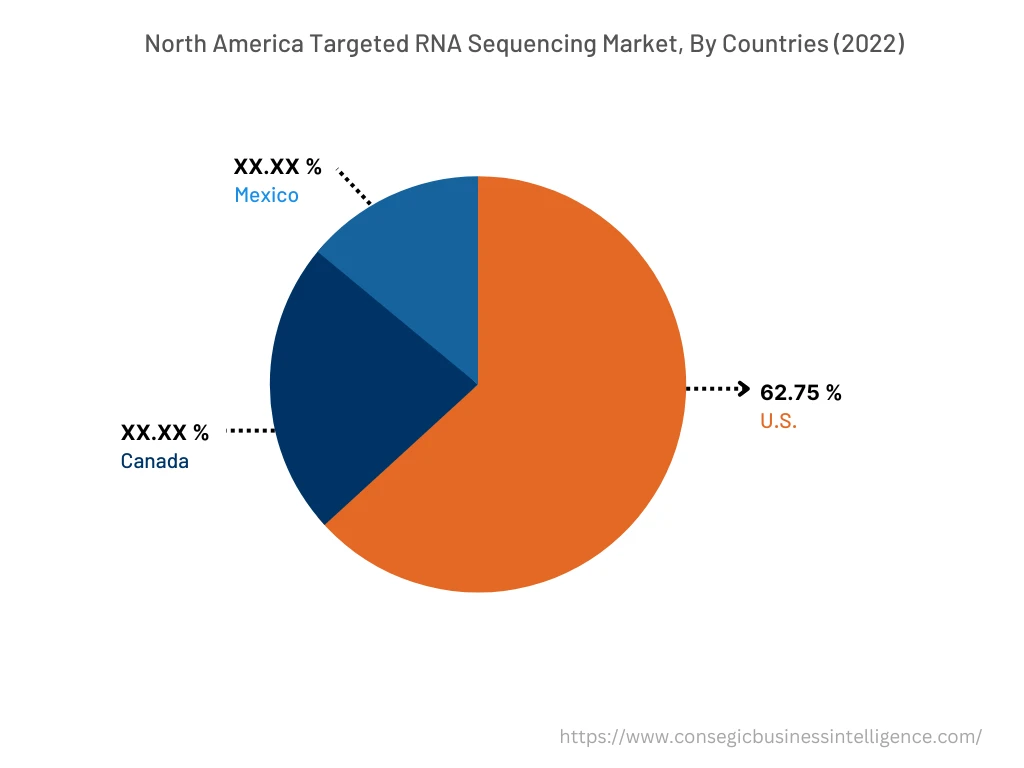
Top Key Players & Market Share Insights:
The targeted RNA sequencing market is highly competitive, with several large players and numerous small and medium-sized enterprises. These companies have strong research and development capabilities and a strong presence in the market through their extensive product portfolios and distribution networks. The market is characterized by intense competition, with companies focusing on expanding their product offerings and increasing their market revenue through mergers, acquisitions, and partnerships. The key players in the market include-
- Roche Holdingss
- Thermo Fisher Scientific
- BGI
- Bio-Rad Laboratories, Inc.
- PierianDx
- Illumina, Inc.
- Agilent Technologies
- Oxford Nanopore Technologies
- DNASTAR Inc.
- QIAGEN
Recent Industry Developments :
- In August 2022, QIAGEN, a leading player that offers sequencing expanded the next-generation sequencing (NGS) portfolio with the introduction of QIAseq UPXome RNA Library Kit, a new set of standards in preparing samples for determining the nucleic acid sequences. Thus, the recent launches associated with the RNA sequencing solutions will create a lucrative growth opportunity for the market in the upcoming years.
- In June 2020, Illumina, headquartered in the United States launched three new RNA sequencing product ranges, including Illumina Stranded Total RNA Prep with Ribo-Zero Plus, Illumina Stranded mRNA Prep, and Illumina RNA Prep with Enrichment. These product ranges are ideal for the study of RNA for oncology, infectious disease, and genetic disease research. Thus, the introduction of new products is leading to the advancement of the global targeted RNA sequencing market.
Key Questions Answered in the Report
What was the market size of the targeted RNA sequencing industry in 2024? +
In 2024, the market size of targeted RNA sequencing was USD 5,079.37 million.
What will be the potential market valuation for the targeted RNA sequencing industry by 2032? +
In 2032, the market size of targeted RNA sequencing will be expected to reach USD 9,726.41 million.
What are the key factors driving the growth of the targeted RNA sequencing market? +
Increasing the application scope of targeted RNA sequencing in the drug discovery process is driving the market growth.
What is the dominating segment in the targeted RNA sequencing market by technology? +
In 2024, the exome sequencing segment accounted for the highest market share of 42.50% in the overall targeted RNA sequencing market.
Based on current market trends and future predictions, which geographical region will have the fastest impact on the targeted RNA sequencing market's growth in the coming years? +
Asia Pacific is expected to be the fastest-growing region in the market during the forecast period.
